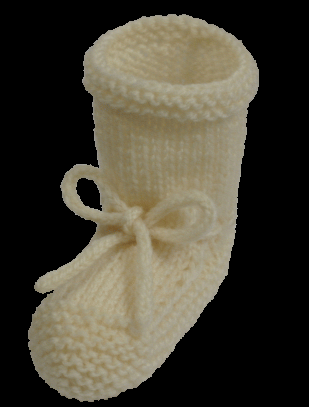Basic Circular Seamless Baby Bootees from the Bottom Up
©Megan Mills, 17th February 2004 |

This bootee is very plain. It focuses on the technique of doing a circular seamless bootee and once you have done this you will be able to adapt most, if not all, other bootee patterns you have that are worked from the bottom up. It is very easy to adjust everything on this bootee. You can change the leg length and foot depth at will. With slightly more planning you can change the circumference, instep length and general size as well as adding any embroidery, colour or stitch patterns that may take your fancy. In fact there is no reason why you could not make an adult-sized bootee (slipper) with this method.
This sample was worked with size 2.75mm needles in 5-ply yarn that wrapped around my ruler 19 times to the inch (just shy of 2.5cm). The gauge was 7 stitches to the inch (2.5cm) measured over stocking stitch and the foot of the bootee measures 10cm (4 inches) long. If you just want to practice the method then do not worry about gauge for once - whatever needles and yarn you choose will still produce the correct shape even if the size is different.
Abbreviations:
K |
Knit |
P |
Purl |
st |
stitch |
st st |
stocking stitch |
g st |
garter stitch |
O |
Over (or yarn forward) |
S1 |
slip one |
K2T |
knit two together |
P2T |
purl two together |
PSSO |
pass the slipped stitch over. |
M1 |
make one by making a backward loop on the needle or picking up a thread and working into the back of it. |
rnd |
round |
Instructions:
Leaving a long tail to use later for grafting and using a provisional cast on method cast on 48 sts and join into a rnd. P24 and mark this as the beginning of the rnds.
Rnd 1: |
K1, M1, K22, M1, K2, M1, K22, M1, K1 |
Rnd 2: |
P |
Rnd 3: |
K1, M1, K23, M1, K4, M1, K23, M1, K1 |
Rnd 4: |
P |
Rnd 5: |
K1, M1, K23, M1, K8, M1, K23, M1, K1. You now have 60 sts. |
Starting with a P rnd work 10 rnds g st (alternate rounds of P and K).
Instep:
K35, S1, K2T, PSSO, turn.
1) S1 P-wise, P10, S1 P-wise, P2T, PSSO, turn.
2) S1 K-wise, K10, S1, K2T, PSSO, turn.
Repeat 1) and 2) five times.
S1 P-wise, P10, S1 P-wise, P2T, PSSO, wrap yarn around 12th st of this rnd, turn, put the just-wrapped st back on the right needle, K11, work the next st together with a st or strand picked up from a rnd below (to avoid a hole), K12 to the end of the rnd.
K one rnd - on the 12th st work the st and the wrap together.
Eyelet rnd:
(K1, O, K2T) 12 times.
Do 15 rnds st st. Starting with a P rnd do 3 rnds g st. Cast off fairly loosely and weave tail around first cast-off st to mimic the chain along the top of the cast-off edge. Put your provisional cast-on sts onto double pointed needles and graft these sole sts together, weave in the ends but do not trim them until after laundering.
To make grafting easier you can use a contrasting, smooth piece of waste yarn and work across all the cast-on sts again. Half will be purled and half will be knitted to maintain the g st pattern. At the halfway point leave a loose loop of yarn so that it will be easy to manipulate later. Now when you graft the two sides together the contrast yarn provides a guide on how to go in and out of the sts correctly. Pull the waste yarn out. Tidy away the ends.
You can use a ribbon for the tie or you can make a twisted, crocheted or knitted cord. I used a 2-st I-cord (made on double pointed needles by casting on 2. Then every row is K2, do not turn. Instead push the sts to the other end of the needle - or transfer them back to the left needle - pull the yarn firmly across the back and K2 again.) When I had made the cord the length I like I threaded the yarn ends on a needle and wove them up through the centre of the cord for a short distance before cutting them off.
Wyszukiwarka
Podobne podstrony:
08b Buciki niemowlęce opis
04b Buciki niemowlęce opis
Buciki niemowlece opis
11b Sweterek niemowlęcy opis
09 Buciki niemowlęce - szydełkiem, ★RĘKODZIEŁO WZORY★, @Szydełkowe buciki@
Okres niemowlęcy i poniemowlęcy
pp1 Zasady z¦çywienia niemowla¦Ęt
Analiza pracy Opis stanowiska pracy
opis techniczny
Ostre zapalenie otrzewnej u noworodków i niemowląt
Opis taksacyjny
OPIS JAKO ĆWICZENIE W MÓWIENIU I PISANIU W ppt
2 Opis RMDid 21151 ppt
Biologiczny rozwój niemowlęcia i okres poniemowlęcy
Bliższy opis obiektów Hauneb
opis techniczny
więcej podobnych podstron